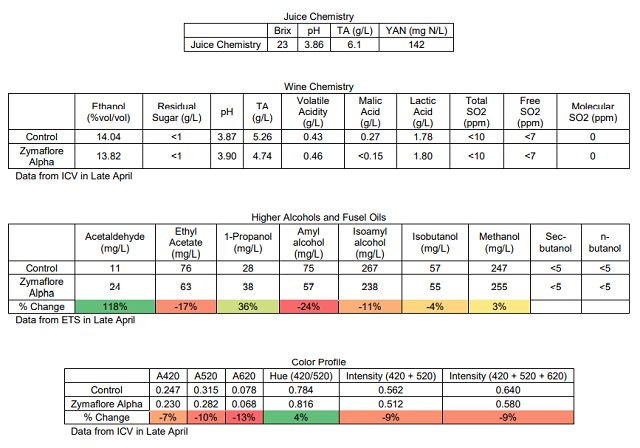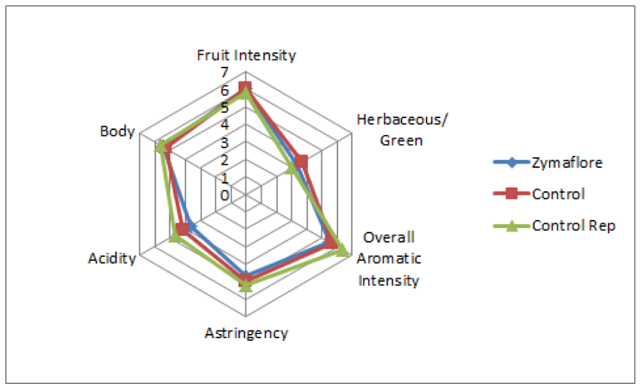The Effect of Zymaflore Alpha Yeast (Laffort) during Cold Soak on Cabernet Franc Wine (2016)
Justin Rose
Rosemont Vineyards and Winery
Summary
This study examines the impact of adding Zymaflore Alpha (T. delbrueckii) (Laffort) yeast prior to a cold soak on the chemical and sensory characteristics of Cabernet Franc wine. Cabernet Franc from the same block was harvested on the same day and processed into two separate T Bins. All additions were identical, except that one T Bin received Zymaflore Alpha yeast and the other received no yeast. Both bins then underwent a 6 day cold soak at 50°F. After cold soak, both bins were inoculated with FX 10 yeast. All other treatments were identical. Wine was pressed around 3 weeks after processing. The Zymaflore treatment lowered titratable acidity and slightly lowered ethanol, but otherwise no major chemistry differences were apparent between wines. The Zymaflore treatment had increased acetaldehyde and propanol, but most other higher alcohols and fusel oils were lowered by the treatment. The Zymaflore treatment also slightly lowered color intensity. Triangle testing showed that, of 7 people who answered, 4 people chose the correct wine (57%), suggesting that the wines were not significantly different. However, the wines were almost significantly different. 3 out of 4 judges who answered correctly preferred the Zymaflore treatment to the control, and the other judge had no preference. The wine with Zymaflore was described as being slightly smoother, less harsh, or more balanced in terms of acidity. No major trends were discovered for the descriptors used in this study. There was a slight tendency for the Zymaflore wine to have lower Astringency and Overall Aromatic Intensity. The use of non-Saccharomyces yeast strains merits further work.
Introduction
Non-Saccharomyces yeasts are often thought to add complexity to wine, but have historically only been present to any considerable extent in uninoculated, unsulfured fermentations. These fermentations add risk to winemaking, as bacterial populations present may have an opportunity to negatively impact the fermentation and produce spoilage compounds. Recently, commercial non-Saccharomyces yeasts have been made available which may mimic or even improve upon the qualities normally found in native fermentations. Since non-Saccharomyces yeasts are generally present only in the initial phases of fermentation before Saccharomyces takes over, commercial versions of these yeasts are often added to cold soaks both to improve wine aromatics as well as to help protect the wine from oxidation and the growth of other micro-organisms. This study examines the impact of one such non-Saccharomyces yeast (Zymaflore Alpha, Torulaspora delbrueckii). This yeast is marketed as being a low producer of volatile acidity and acetaldehyde, and enhances aromatic diversity and intensity (Laffort 2017).
Results and Discussion
The Zymaflore treatment lowered titratable acidity and slightly lowered ethanol, but otherwise no major chemistry differences were apparent between wines. The Zymaflore treatment had increased acetaldehyde and propanol, but most other higher alcohols and fusel oils were lowered by the treatment. The Zymaflore treatment also slightly lowered color intensity. For the triangle test on May 17, of 7 people who answered, 4 people chose the correct wine (57%), suggesting that the wines were not significantly different. These wines were voted to have an average degree difference of 4.3 (out of 10), suggesting that the wines were moderately different. 3 out of 4 judges who answered correctly preferred the Zymaflore treatment to the control, and the other judge had no preference. The wine with Zymaflore was described as being slightly smoother, less harsh, or more balanced in terms of acidity. No major trends were discovered for the descriptors used in this study. There was a slight tendency for the Zymaflore wine to have lower Astringency and Overall Aromatic Intensity. Many more studies are needed on the impacts of different non-Saccharomyces yeasts on wine quality.


Methods
Cabernet Franc (13 year old vines, clone 214 planted on 3309) was harvested on 9/19/2016 and processed on 9/20. The grapes were split into two T Bins, each of which received 30g/hL VR Supra, 2g/L Untoasted French oak chips, 30ppm sulfur dioxide, and 40g/ton Lafase HE Grand Cru Enzyme. The treatment bin also received Zymaflore Alpha yeast (T. delbrueckii, Laffort) at 30g/hL with Dynastart. Both bins received a 6 day cold soak, after which they were both inoculated with FX 10 at 25g/hL with 30g/hL Dynastart. During fermentation, both treatments received 0.5g/L tartaric acid, 15g/L Thiozote, and 30g/hL Nutristart Org. Both treatments received two punch downs per day until 3 Brix, after which they received one punch down per day until pressing (10/12). After pressing Lactonenos 450 PREAC malolactic bacteria was added.
This project was tasted on May 17. For the triangle test and preference analysis, anybody who did not answer the form were removed from consideration for both triangle, degree of difference, and preference. Additionally, anybody who answered the triangle test incorrectly were removed from consideration for degree of difference and preference. Additionally, any data points for preference which did not make sense (such as a person ranking a wine and its replicate at most and least preferred, when they correctly guessed the odd wine) were removed.
In order to balance the data set to perform statistical analysis for descriptive, any judge who had not fully completed the descriptive analysis ratings were removed. In order to then make the number of judges between groups equivalent, one judge from group 2 was eliminated. This resulted in a final data set of 3 groups, each with 2 judges (considered as replications within groups, and groups were considered as assessors). Data was analyzed using Panel Check V1.4.2. Because this is not a truly statistical set-up, any results which are found to be statistically significant (p<0.05) will be denoted as a “strong trend” or a “strong tendency,” as opposed to general trends or tendencies. The statistical significance here will ignore any other significant effects or interactions which may confound the results (such as a statistically significant interaction of Judge x Wine confounding a significant result from Wine alone). The descriptors used in this study were Fruit Intensity, Herbaceous/Green, Overall Aromatic Intensity, Astringency, Acidity, and Body.
References
Laffort. 2017. Torulaspora Delbrueckii – Handcrafting the biodiversity. http://www.laffort.com/en/products/470-zymaflore-alpha. Accessed on 5/19/2017.
